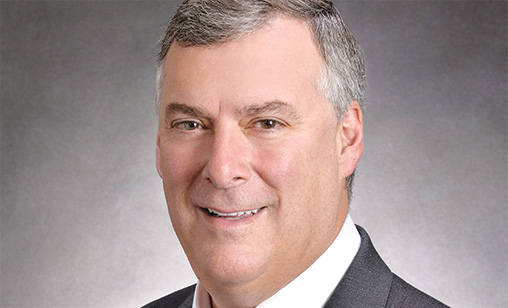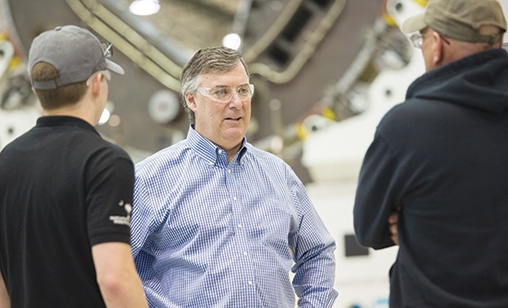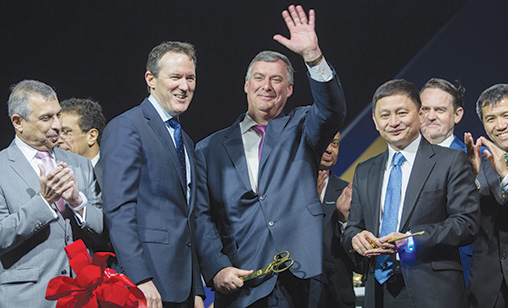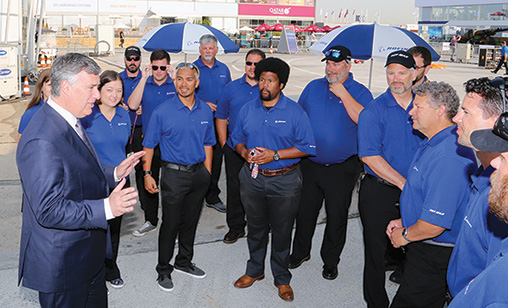Cover Story
Building a smarter business
May was a testing time for the Boeing Commercial Airplane Company. Within days mid-month, President Trump took the U.S. out of the multi-nation nuclear agreement with Iran – a decision with a direct impact on Boeing’s order book – and reversed his planned policy for tariffs on Chinese goods. In an exclusive interview with Orient Aviation, Boeing’s Kevin McAllister said the group was following U.S. policy “very thoroughly”, but that he was focused on making Boeing a smarter business.
June 1st 2018
He is the executive vice president of The Boeing Company and president and chief executive officer of Boeing Commercial Airplanes (BCA), but Kevin McAllister has never forgotten the lessons he learnt from his childhood city of Bethlehem, Pennsylvania. Read More »
“I am a steel town boy,” he told Orient Aviation last month. McAllister said he grew up close to a factory complex that was once the second largest steel producer in America. It built war ships and revolutionary steel girders for sky scrapers, but today it is no more. Bethlehem Steel ceased production in 1995 and entered bankruptcy in 2001 after 132 years of astonishing engineering feats and manufacturing records.
 |
“For me,” McAllister said, “that time has been a very big influence on my life. I saw the tough times the steel industry went through because it did not recapitalize and reinvest. It’s something I think about every day.
“In fact, in my office you will see I keep a painting of that steel mill above my desk. It is a reminder every day of the need to continually focus on a more competitive Boeing, a more agile company. That’s a big focus for me.”
His steel town roots have been on s how since he arrived at BCA in November 2016 after 28 years with GE. He has quickly become a familiar face with the 60,000 commercial airplane employees because of his regular visits to the factory floor.
“It is very important for leaders to be out on the floor so they understand what it takes, where the truth is and how to respond to it. They must be great listeners,” he said. “The thing I am most proud of in the 18 months [since I have been here] is that our people come to work every day wanting to build the best airplanes in the world,” he said.
“The best days I have are with customers or walking the factory floor to find out from our people what we can do to be more competitive, faster and more agile. We have launched “Plane and Simple” to capture prolific ideas from the factory floor and accelerate them into changes. I am incredibly proud of Boeing people on the floor: in engineering, across our operations, across the franchise. Everyone is working together to win.”
In McAllister’s first full year in charge – 2017 – the business was in a sweet spot that has continued into 2018. For the 12 months to December 31, 2017 the OEM reported operating cash flow of $13.3 billion on revenue of $93.4 billion. It delivered a record of 763 jets to customers worldwide and reported a healthy order backlog 5,864 aircraft valued at $488 billion for the 12 months. The delivery record was driven by high output of the manufacturer’s B737 and B787, BCA said.
For the first quarter of this year, BCA earned revenue of $13.7 billion and achieved an operating margin of 11%. It confirmed 221 orders and delivered 184 jets in the three months, including the first B787-10 Dreamliner to Singapore Airlines and the first B737 MAX 9 to Indonesia’s Lion Air Group.
“Obviously, if you look at the airline industry today, profitability is very healthy and passenger traffic is outpacing GDP so it’s a very good market,” said McAllister. “There are a couple of things [in play]. Firstly, there has been very strong discipline in the market on capacity balanced with traffic.
“The growth we see around the world has been reducing some of the historical cyclicality we have seen in the industry. Another factor is the strength of the freight market, which is important for Boeing.
| Boeing Embraer discussions “not a response to anything” Boeing Commercial Airplanes president and CEO, Kevin McAllister, confirmed to Orient Aviation last month that talks are continuing with Brazilian regional jet maker, Embraer. “From our standpoint, a combination with Embraer would be a win-win. It offers some great growth opportunities for both companies,” McAllister said. “There is synergy not only with product lines but the capabilities both of us. I think it’s a great strategic fit. It’s not a must do for Boeing. Our conversations continue and we are very respectful of those. “We’ll see what happens.” McAllister said it would not be appropriate for him to comment on Brazilian concerns about the defence side of Embraer’s business, but he firmly denied the move was merely a reaction to Airbus’ majority purchase of the Bombardier’s C Series regional jet program. “In Boeing we spend an awful lot of time looking downstream and game-boarding. I would simply say we are very confident about our game-board and clearly it has not been a response to anything,” he said. |
“It’s been a good past year, but we are keeping our heads down and focusing on technology to find ways to transform operations and build our competitive edge. We are putting a lot of time into building new capabilities and driving culture across the company.”
While all of this reads like the best of times for Boeing, there has been no shortage of issues beyond BCA’s gates to exercise McAllister. They range from U.S. tariffs on a range of Chinese goods to U.S. President Trump’s withdrawal from the Iran nuclear agreement. The Iran decision could have resulted in a 80-plane order, worth $16 billion at list prices.
Also on the to-do list are Rolls-Royce’s problems with its Trent 1000 engines that have effected almost 25% of the global B787 fleet.
McAllister told Orient Aviation: “While Boeing today has 90% of its people in the U.S. we have people around the world in 65 different countries. We keep a very strong global footprint, so it is very important to understand what is happening in local markets.
“As far as our business is concerned, we have to anticipate risks and make sure we have the right play books in place. Obviously, we encourage a good dialogue in countries like China. We are very hopeful of a good outcome.” When it comes to Iran, Boeing is clearly in no position to do much about President Trump’s decision.
On the Trent engine issue, he “regrets very much” the challenge this has created for Boeing customers. “It has been a significant operational disruption. We have reacted to this by working very closely with Rolls. I have put a very large team in place with Rolls, many of them in Derby, on a fuel field service inspection and management plan to minimize disruption to our customers,” he said. “We are working very closely with Rolls to be in compliance with the airworthiness directives.”
 |
 |
 |
 |
In the meantime, the drive to bring new models to the market is all about execution. “Ahead for us is the B737 MAX 7, which is in flight test right now and going smoothly. With the MAX 10, we are going to bring an airplane [to the market] with up to 230 seats in a single-class layout. It will have 10 more seats than the MAX-9,” he said.
“We finalized the design last year and are very excited about it. It will produce the lowest seat mile costs for our single aisle customers. We also are very busy with the B777X, bringing the variant of the 777X to markets in 2020.”
To achieve these goals, the complicated nature of today’s jet airplane supply chain, with sections of aircraft manufactured around the world, needs special attention, said McAllister.
“I don’t think you can run an industrial operation as big as this without challenges. There are always challenges around the operations of the supply chain. We make sure we have a good forward look on the performance of suppliers. We’ve had a couple of challenges here and there that we have jumped on very quickly and we’ve been able to execute on them.”
One of those involved a low-pressure disc issue with the CFM International high-bypass turbofan LEAP engine for the MAX aircraft. “I bring a unique perspective to this. Coming from the engine business I can tell you that the way CFM reacted, from understanding the issues to taking the steps needed to solve the problem, was so quick. For us, it was very successful. We were able to meet our deliveries for 2017 and to deliver to our customers in 2018,” he said.
Asked about the B747-8 Intercontinental, the latest version of the B747 jumbo jet, McAllister said the production line is only producing freighter versions. The passenger model has not attracted an order in recent times. The situation has confirmed Boeing’s long-held view that airlines want smaller wide bodies rather than high capacity jets.
Earlier this year, UPS (United Parcel Service) ordered 14 B747-8s. “With the strength of the market there is a lot of demand on the B747-8 but also very, very strong demand for B777 freighters,” he said.
What about the all-new B797? “This is still a study and we have not yet named it but we have spent a lot of time looking at the space between the single aisles and the twin aisles. We call it the middle of the market. At this point, we have made no decision to launch the airplane or not,” McAllister said.
“We have time. It is an airplane that would enter the market, if we decide to launch it, in late 2024 or 2025. We are embedded with more than 50 customers and are very focused on understanding the airplane’s economics and how it would fit into their networks.
“We are encouraged by the discussions and dialogue we have had. They are continuing. We see an airplane with single aisle efficiency and twin aisle comfort for passengers, carrying 220-270 passengers up to 5,000 nautical miles.
“We must bring to the board - Boeing Group chairman, president and CEO, Dennis Muilenburg and the directors - an understanding of the right market, an understanding of the right airplane and also the right business plan if we choose to go ahead.”
Not surprisingly, the Asia-Pacific, and particularly China, is very much a part of Boeing’s forward planning. Last month, McAllister did a quick scoot around the region to talk to several airline leaders in China and Japan.
“Our long-term projections, to 2036, are that the region will be 40% of global passenger traffic. A major development [in the region] is the dynamic growth being driven by strong liberalization in ASEAN open skies. It will drive more growth within the region beyond national boundaries. We are excited to participate in that,” he said.
“We have had a 45-year strategic relationship with China. Today, we deliver one of every four airplanes we produce to the China market. We have something like 1,600 aircraft in service in China.
“But China has been not only a great customer, Boeing has been a great partner. Boeing has helped China connect, using our airplanes, across China and with the rest of the world. We enjoy very deep relationships with our Chinese customers and we work really hard to find out where there are good win-win opportunities, like our finishing and delivery centre for B737s at Zhoushan. It is expected to open later this year.
“We also have excellent co-operation in Shanghai on B737 freighter conversions as well as a large number of partners in China that we count on every day to be suppliers across our airplane programs,” said McAllister.
Interestingly, unlike some of his predecessors, McAllister does not believe in attacking long-time rival, Airbus, or engaging in verbal battles with Toulouse. “As a CEO I focus on the imperative of delivering on the commitment we gave to our customers. That’s a daily thing,” he said.
“What’s important to me is to have a ‘say to do’ ratio of one, that is doing what we say we are going to do when we bring an airplane to market, whether it’s a single aisle, a twin aisle, a passenger aircraft or a freighter aircraft.
“It’s incredibly important we differentiate ourselves versus our competitor with the best value and the best operating economics, the highest efficiency and the best revenue generation capability for our customer. We must harness the collective capability, not only of our airplane business but the collective capability of our services business so we help manage through lifecycle costs.”
McAllister is committed to digital technology. “We are bringing the capability of digital to the factory floor to collectively work out how to place airplane parts and information into the hands of our mechanics when they need them. Digital is allowing us to improve flow efficiency and quality, reduce costs and better fulfil our delivery commitments. By investing in differentiating technologies we have done a lot to focus on culture. That is a great enabler for our workforce,” he said.
As for the challenges ahead, McAllister said that BCA must be very close to its customers and also understand when the market is changing. Secondly, “we must never res and always invest in strengthening our competitive edge”, he said.
| Dedicated to delivery Boeing Commercial Airplanes president and CEO, Kevin McAllister, (54) may have only been with Boeing for 18 months, but he is no stranger to the aerospace business. A graduate of the University of Pittsburgh, where he earned a bachelor’s degree in materials engineering, he told Orient Aviation he has “worked his way through the supply chain”. Before he settled in at GE Aviation in 1989, his first industry job was with aviation components supplier, Howmet Corporation. At GE he initially joined as a metallugical engineer and held various materials engineering leadership roles supporting product design, manufacturing, component repair and technology development. McAllister moved to GE Aviation Services in 1998 as a Master Black Belt leading Six Sigma productivity improvements across the global network of Component Repair Operations. Later that year he was selected to lead Six Sigma programs across Services, including Overhaul & Repair Operations, Materials, Engineering and Marketing & Sales. In 2000, he was appointed general manager of the new GE Engines Services Customer Satisfaction Organization and from 2001 to 2005 was general manager of global customer and product support operations worldwide. He then moved to GE Aviation Services to lead worldwide Sales and Marketing for GE Aviation. Before joining Boeing in late 2016, he was president and CEO of GE Aviation Services, a $9-billion plus business that helps operators of the more than 34,000 GE and CFM commercial engines in service to achieve the lowest life cycle cost of ownership for the power plants. At Boeing he is responsible for delivering on a record backlog and overseeing the growth of all commercial airplane programs. Boeing Commercial Airplanes accounts for more than 60% of Boeing’s total revenue. It has nearly 12,000 commercial jetliners in service worldwide and supplies approximately 75% of the global airline fleet. A member of the Board of Directors for the Washington Roundtable, where senior executives work together to enhance economic growth in the Washington state, he also is chairman of the board of directors of Orbis International. The non-profit global organization is dedicated to preserving and restoring sight worldwide to people without access to restorative ophthalmologic care. “It is really important to be a good leader if you aspire to be a great leader. Being a good leader is spending time in your local community, but also it is helping others. I am very proud of what Orbis does as we work to eliminate blindness,” he said. “Orbis builds capacity in emerging countries to cure blindness. It is a very important priority in my life. At the times when you want to get your head out of work and do something else that also matters Orbis is a great way to do that.” Aa a past president and a member of the board of Governors of venerable The Wings Club, a global society of aviation professionals and a leading forum for aviation issues, McAllister told Orient Aviation: “I don’t know too many kids growing up who were not mesmerized by airplanes. For me, it was something I probably discovered later in my childhood and into my adult life. The son of two mathematicians, his name clearly reflects his Scottish roots although his forebears moved to Ireland before they decided to settle in the U.S. His mother is Italian so he is “blessed with Scottish, Irish and Italian blood”, he said. He enjoys a golf game when time permits. “It seems to be a perpetual struggle for me to play the game well. I would say I’m high on interest but low in execution in the golf category,” he said. He also loves to read as well as meeting his customers worldwide to better understand their requirements and their businesses. |